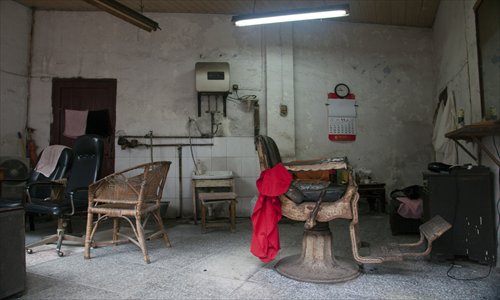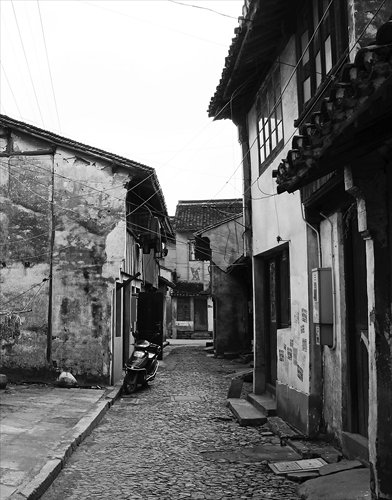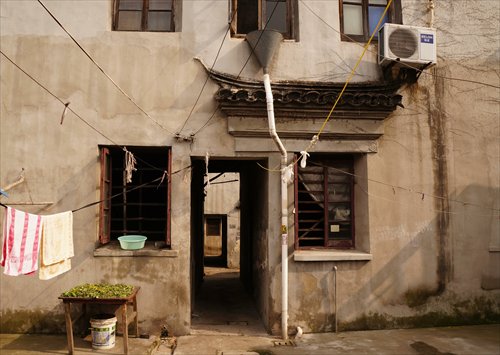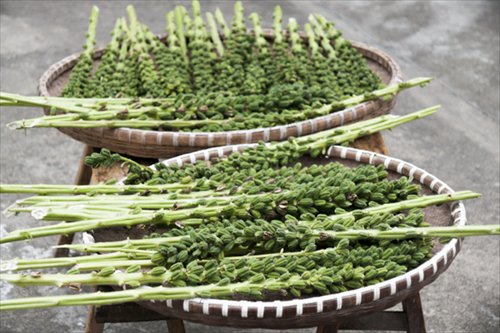Loutang

A local barber shop
Search for "Loutang ancient town" on dianping.com, the largest consumer rating site in China, and you won't see the thousands of reviews for entries like "Zhujiajiao ancient town" or "Qibao ancient town" but only one single review, which reads, "Time and space here seem to have stopped, making you feel as if you were in a town south of the Yangtze River in the 1970s and 80s. Without the uproar of commerce, the town exists in an easy and comfortable state."
Six kilometers north of the urban area of Jiading district and located right inside the Jiading Industrial Zone, the town of Loutang has been around for more than 600 years since the Ming Dynasty (1368-1644), but it is nowhere near as well known as the tourist-packed ancient towns around the city. But recently, an exhibition in downtown Shanghai has brought the little-visited town under the spotlight.
Divided into five themes, the exhibition, entitled Lou Town: Prologue, gives a general but interesting introduction to the riverside town through its history, people, customs, religious beliefs and shops.

Ancient houses in Loutang
A 10-minute video tells the history, geography, demography as well as the architectural styles of Loutang with photos and animations. Meanwhile, profiles of 12 elderly residents - the oldest among them being 93 years old - silently narrate the stories of village life in the past.
Also on view are various photo series featuring a Catholic church built in the Qing Dynasty (1644-1911) and its local parishioners, everyday objects in locals' homes, and traditional barbershops that have been in business for more than two decades.
"If we hadn't talked to those old people, the precious memories of Loutang would probably be gone with them within several years," said Fan Jingwen, the curator of the exhibition and a member of Helin Art in Community, a local NGO dedicated to sustainable community development through natural science and art projects.
Since the end of 2012, while visiting local craftsmen in towns in and around Shanghai, volunteers and staff members of Helin Art in Community have been conducting field investigations in Loutang, sparking their interest in the town's distinctive characteristics.
In 2005, the municipal government designated Loutang as a historical and cultural area, protecting buildings typical of different historic periods, such as the stores along the streets with detachable wooden covers, the former State-owned factory sites of the 1960s and 70s, and the enormous houses of wealthy families that combine the architectural styles of the Qing dynasty and the Republican period (1912-49).

Ancient houses in Loutang
"It's a place where the old meets the new. There are factories around and even inside the ancient town, which you can say affect the original landscape of the town but are also part of its current landscape," Fan said, who holds a postgraduate degree from the University of London's School of Oriental and African Studies.
Helin Art in Community's major field investigation in Loutang started last August, according to Yang Xin, who is in charge of the Loutang project.
As its name implies, the exhibition functions only as a prologue of the whole Loutang project. Nowadays, the once prosperous ancient commercial center has become the lonely home of old residents, whose offspring mostly opted to move to urban areas in Jiading and Shanghai. Migrant workers now make up two thirds of Loutang's population. Yang's team plans to organize activities to stimulate vitality in the town and create more friendly community relations between locals and migrant workers.
A poster at the ongoing exhibition outlines their goals step by step: to organize a temple fair this year; to bring back traveling salesmen by 2015; to open a teahouse that functions as an open community art workshop; and to regenerate vitality in the local community by 2020.
"The main concerns of the project include, firstly, how to make sure that the public cultural activities will intrigue the locals and meet their needs, and secondly, how to revive the group cohesiveness of the local community and facilitate its self-reliance and healthy development," said Yang.

Fresh sesame Photos: Courtesy of Li Tian and Yang Xin
So far, the project has received both financial and human resource support from Shanghai University, YouChange China Social Entrepreneur Foundation and Minsheng Bank, and Yang said that they look forward to cooperating with the local government as well in the future.
Helin Art in Community is not the only NGO in China seeking to revive community vitality. A social service team comprised of returning college students in Hainan Province has been serving local elders, publicizing knowledge of disease prevention, teaching local students, and building libraries and roads in their hometowns since 2002; and in Ji'an, Jiangxi Province, the non-profit organization IFChina Original Studio is dedicated to running cultural programs in local communities, including redesigning public space, organizing summer camps for children and recording local history through films, photographs, interviews and original plays.
On January 19, representatives from NGOs and the interviewed old residents of Loutang will gather at the exhibiting venue with members of Helin Art in Community, sharing more stories of Loutang and of community rebuilding.
Date: Until February 28, 10 am to 7 pm (closed on Tuesdays)
Venue: Gongyi Xintiandi
公益新天地
Address: 1/F, Bldg 4, 105 Puyu Road West
普育西路105号4幢1层
Admission: Free, reservations needed for visits on weekdays
E-mail ngosdefringe@126.com for reservations